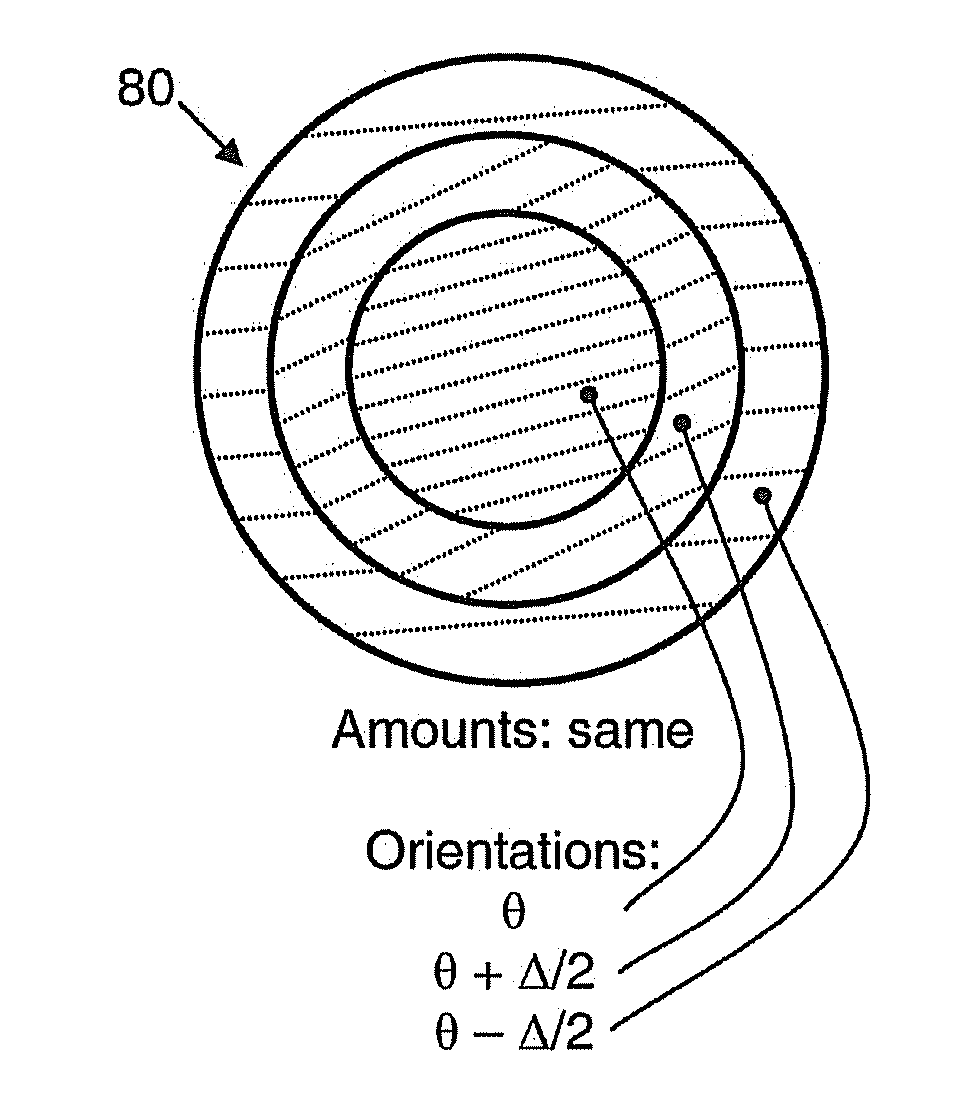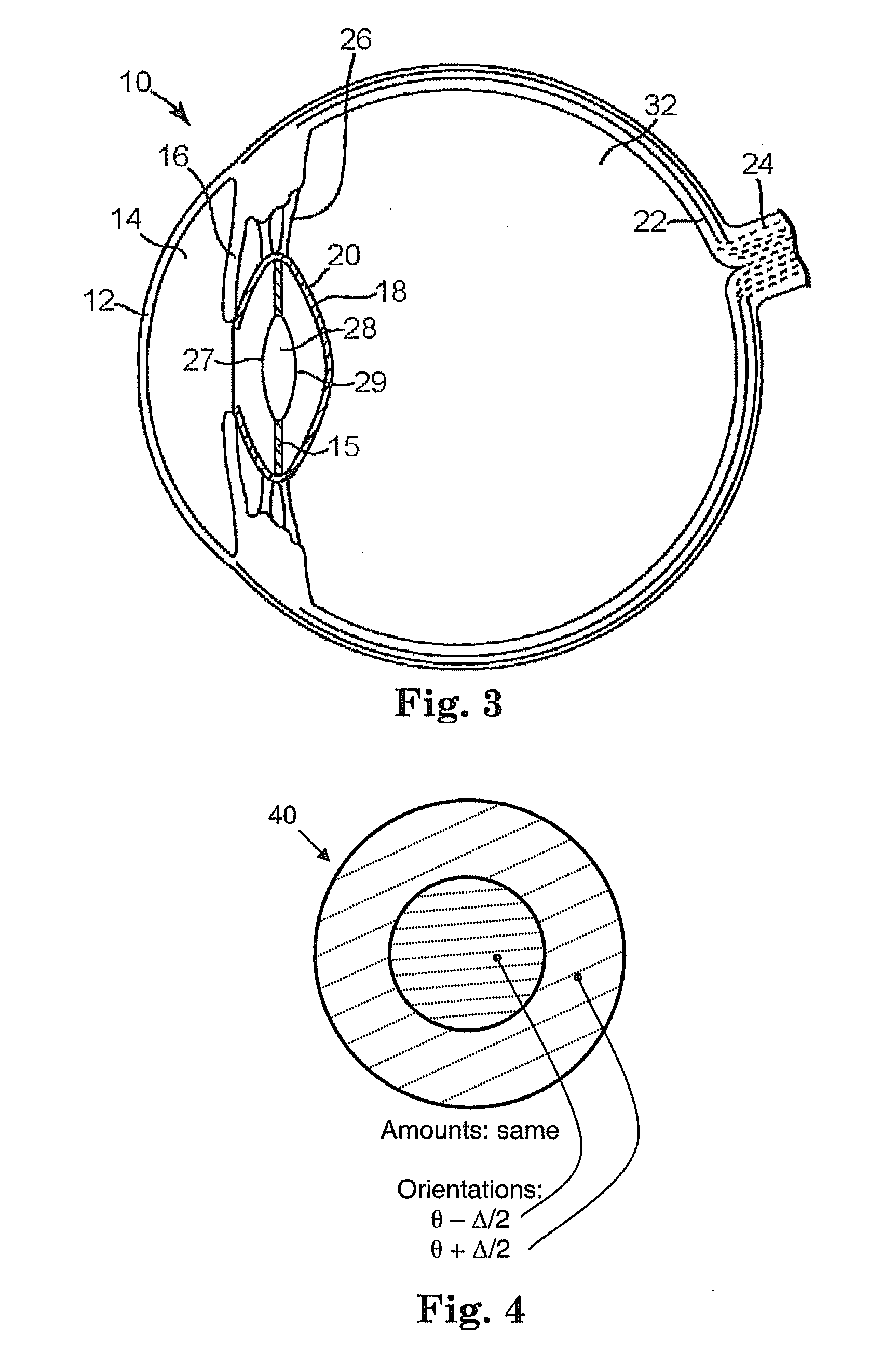Toric intraocular lens with modified power characteristics
a technology of power characteristics and intraocular lens, applied in the field of intraocular lens, can solve the problems of degrading the vision of the eye, inability to correct, and difficulty in equal-but-opposite astigmatism correction
- Summary
- Abstract
- Description
- Claims
- Application Information
AI Technical Summary
Benefits of technology
Problems solved by technology
Method used
Image
Examples
first example
[0095]FIG. 18 is a graph that depicts power versus radial position (along a meridian) for a first embodiment of a toric lens having radially modulated characteristics. FIG. 19 is a schematic drawing of an optical element or lens 200 having a clear aperture 201 and the power characteristics depicted in FIG. 18 (as used herein, the term “clear aperture” means the opening of a lens or optic that restricts the extent of a bundle of rays from a collimated source or a distant light source that can imaged or focused by the lens or optic). In FIG. 19, the horizontal axis represents the low power meridian (labeled “L”) and the vertical axis represents the high power meridian (labeled “H”). For this example, r0 is the originating position (which has a value of zero in the illustrated embodiment), r1 is the radial position that defines a central zone 202, r2 is the radial position that defines the outer boundary of an intermediate zone 204, and r3 is the radial position that defines the outer ...
second example
[0103]The plots in FIG. 18 define the nominal power PN in the central zone 202, the overcorrecting power POC in the intermediate zone 204, and the undercorrecting power PUC in the outer zone 206. In contrast, FIG. 20 is a graph that depicts power versus radial position (along one meridian) for a different embodiment of a radially modified toric lens. Here, the central zone (between r0 and r1) has an overcorrecting lens power, the intermediate zone (between r1 and r2) has the nominal lens power, and the outer zone (between r2 and r3) has an undercorrecting lens power. As mentioned above with reference to FIG. 18, the general characteristic of the plot in FIG. 20 may be followed by some or all of the meridians of the optical element. Moreover, the values of POC, PN, and PUC may vary with the meridian angle θ according to any of the embodiments described above in relation to FIGS. 18 and 19. For example, the power along the low power meridian 217, or one or more other meridians, may co...
third example
[0104]FIG. 21 is a graph that depicts power versus radius for a toric lens, where the power monotonically decreases in a stepwise manner. The power characteristic depicted in FIG. 21 may be realized using a toric lens having five annular zones that are defined by the five radii (labeled r1 to r5 in FIG. 21). In practice, the number of steps and the height of each step will be chosen to best suit the needs of the given patient or class of patient. In certain embodiments, the power along one or more meridians may decrease in a continuous manner in one zone and decrease in stepwise manner in another zone. In other words, the modification scheme may result in a “hybrid” approach that combines continuous and stepwise transitions along a given meridian. The values of POC, PN, and PUC may vary with the meridian angle θ in an absolute or relative sense according to any of the embodiments described above in relation to FIGS. 18 and 19. In some embodiments, the power POC in FIG. 21 along a hi...
PUM
 Login to View More
Login to View More Abstract
Description
Claims
Application Information
 Login to View More
Login to View More - R&D
- Intellectual Property
- Life Sciences
- Materials
- Tech Scout
- Unparalleled Data Quality
- Higher Quality Content
- 60% Fewer Hallucinations
Browse by: Latest US Patents, China's latest patents, Technical Efficacy Thesaurus, Application Domain, Technology Topic, Popular Technical Reports.
© 2025 PatSnap. All rights reserved.Legal|Privacy policy|Modern Slavery Act Transparency Statement|Sitemap|About US| Contact US: help@patsnap.com



